If you love crunchy textures but follow a low-carb or keto lifestyle, a low carb air fryer can be a game-changer. It delivers that crisp, roasted finish you crave while usually using a fraction of the oil of deep-frying, which helps keep carbs and unnecessary calories in check. This guide walks you through why a low carb air fryer is great for keto cooks, how to choose the right model, quick troubleshooting, and recipe ideas that actually sing.
Benefits of Air Fryers for Low-Carb Diets
Air fryers are more than a kitchen fad — for people cooking low carb or keto, a low carb air fryer can change the way you make crispy, satisfying food without piling on extra carbs or oil. Below, I expand each benefit with real, actionable tips so you can use your low carb air fryer like a pro.
Crisp Texture with Minimal Oil
- What happens: A low carb air fryer crisps food by circulating very hot air around the food, so surface moisture evaporates quickly and proteins/cheeses brown — giving that crunch people crave with minimal oil. That means you can get a golden crust on almond flour breading, pork-rind crusts, and even thin vegetable “fries” without deep-frying. (1)
- Why this matters for low-carb: Traditional breading and deep-frying rely on high amounts of oil and carb-heavy crumbs. Swap to crushed pork rinds, almond flour, or cheese coatings, and your macros stay intact while texture improves.
- Practical tips to maximize crisp:
- Dry first. Pat veggies and proteins very dry — moisture is the enemy of crisp.
- Single layer = crisp layer. Don’t overlap pieces; give hot air room to circulate.
- Light oil mist only. Use a small spray or brush of oil (or no oil if using cheese coatings) — often a teaspoon is enough.
- Preheat the basket. A hot basket jumps the browning reaction and seals coatings faster.
- Quick example: For almond flour zucchini fries, dredge, press coating firmly, preheat to 400°F, and air-fry 12–15 minutes, flipping once — you’ll get brown edges without deep frying. (2)
Faster Cooking Times than Ovens
- Speed advantage explained: Because an air fryer’s cooking cavity is smaller and the fan-driven convection is intense, it often reaches target temperatures and cooks food 20–30% faster than a conventional oven for comparable items. For busy low-carb cooks, that quick turnaround matters. (3)
- Why speed helps low-carb cooking: Faster cooking means less time at high heat (which can preserve texture and reduce nutrient loss) and more efficient weeknight meal prep — especially when you’re batch-cooking proteins and veggies separately.
- Actionable timing hacks:
- Cut food uniformly — equal-sized pieces cook evenly and finish at the same time.
- Stagger batches — cook dense items first, then quick-frying items to reuse residual heat.
- Use multi-drawer or dual-zone models when cooking different items simultaneously (one basket for veggies, one for coated proteins).
- Energy-time tradeoff: The faster cook time also contributes to energy savings (covered more in section 2.4), making the low carb air fryer a practical appliance for everyday use. (4)
Better Fat Rendering & Texture for Meats
- How air fryers treat meats: A low carb air fryer concentrates heat at the surface, which helps render fat from chicken skin, bacon, or fatty cuts so you get a crisp exterior and juicy interior — without dunking the protein in oil. That rendering gives you a texture that mimics frying but with fewer added fats. Practical for keto, where fat is a feature, not a problem. (5)
- Science note: Studies show frying temperature and time can change fatty acid profiles and influence how fat exchanges between food and added oil; using an air-fryer-style method often reduces added oil uptake compared with deep-fat frying. That matters if you want to control the type and amount of fat on your plate.
- Cooking tips for perfect results:
- Use a probe for thick cuts. A meat probe prevents overcooking — perfect for chicken thighs or small roasts.
- Trim and score skin. For poultry, a couple of shallow scores let fat render and escape rather than pool under the crust.
- Finish at a higher temp. Sear at a higher temperature for the last 2–4 minutes to crisp skin or crust without drying the interior.
- Keto-friendly idea: Air-fry bacon or pancetta on a raised rack so fat drips away; the result is crispy bacon with less grease on the final dish — excellent for salads or topping casseroles.
Energy Use & Efficiency
- Short answer: For small-to-medium portions, a low carb air fryer is typically more energy-efficient than a full-size oven because it heats faster and cooks in less time. Several appliance-energy analyses and tests back that up.
- Why it’s more efficient (in practice):
- Smaller cavity = less air to heat. Faster heat-up and less idle power.
- Shorter cook times. Even if the wattage is similar to an oven, total energy (watt × hours) is often lower because the job finishes sooner.
- Targeted cooking. You don’t waste energy heating an entire conventional oven for one small tray of low carb snacks.
- When the oven wins: For very large batches (a full turkey or multiple sheet pans), a conventional oven is more efficient per pound/cup of food, so choose tools by scale.
- Practical energy-saving tips:
- Cook back-to-back. Use residual heat from the previous batch when doing multiple items.
- Match batch size to appliance: single-serve or 2–4 servings = low carb air fryer; large family holiday = oven.
- Unplug or use a smart plug to avoid phantom standby power when not in use.
- Bottom line: If you’re cooking low-carb dinners, snacks, and reheats for 1–4 people, a low carb air fryer will likely save you time and electricity — and that adds up over weeks and months. (6)
Quick recap & practical checklist
- Crisp with less oil: Use almond flour, pork rind crumb, or cheese coatings and preheat for the best crunch.
- Faster weeknight dinners: Expect 20–30% faster cook times vs the oven for similar portions.
- Great for meat texture: Air fryers render fat cleanly and crisp skin without heavy oil.
- Energy-efficient at small scale: Use your low carb air fryer for 1–4 servings to save time and energy; switch to an oven for large batches.
How to Choose an Low Carb Air Fryer for Keto Cooking
Picking the right low carb air fryer is about matching the appliance to how you cook, not just the flashiest features. Below, I break down the most important decision points — capacity, shape, power, smart features, cleaning, and cost — and give practical, keto-focused tips so you end up with a machine that actually makes your life easier (and your food crunchier).
Capacity: Single vs Family vs Multi-drawer
Why capacity matters for a low carb air fryer
The size you choose affects how crispy foods get and whether you’ll need to run multiple batches. Overcrowding kills crispness — especially important for low carb coatings like almond flour or pork-rind crumbs.
Common capacity buckets & who they suit
- Small (2–3 quarts): best for singles or very small kitchens. Great for quick snacks (cheese crisps, 1–2 servings of veggies).
- Medium (4–6 quarts): the sweet spot for couples and most low-carb weeknight dinners (a few chicken tenders + a side).
- Large (7–10+ quarts) or oven-style: ideal for families, batch-cooking, or making a frittata and sides at once.
- Dual-basket / multi-drawer: lets you cook protein and veggies at different temps — perfect for multi-component low carb plates.
Practical rule: If you regularly cook for 1–2 people, choose a 4–6 qt low carb air fryer. If you batch-cook or entertain, pick a large or dual-zone model to avoid repeated batches that waste time and energy.
Shape & Heating Design: Basket, Oven-style, Vertical/Tower (H3)
Which shape gives the best results for low carb breads and crunchy coatings?
- Basket-style (pull-out drawer with basket):
- Pros: Rapid circulation, excellent at crisping small items (fries, tenders, cheese crisps).
- Cons: Limited surface area for large sheet-baked keto breads.
- Best for: Quick singles and crispy coatings.
- Oven-style / toaster-convection:
- Pros: More even heat for baking keto breads, casseroles, and multiple racks.
- Cons: Slightly slower to heat than basket-style, but more versatile.
- Best for: Bakers who want to make low-carb loaves, crusts, and sheet-pan dinners.
- Vertical / tower-style:
- Pros: Space-efficient and sometimes optimized for frying small batches with minimal oil.
- Cons: Can have hotspots; not ideal for larger pieces of meat.
- Best for: Small kitchens where footprint matters.
Tip for low carb air fryer cooks: If you plan to make both crispy “fried” items and true low-carb bakes (like almond-flour loaves), an oven-style or a hybrid model with racks will give you the most flexibility.
Wattage & Temperature Range
Why wattage and top temp matter for low carb air fryer performance
- Higher wattage = faster heat-up and stronger, drier air circulation, which is crucial for sealing coatings and rendering fat on meats.
- Look for units that can reach at least 400–450°F (200–230°C) for serious browning — useful for pork-rind crusts, seared chicken skin, and cheese-based crisps.
Guidelines
- Under ~1200W: fine for light use and snacks, but may struggle with larger batches.
- 1200–1700W: versatile for most low carb home cooks — good balance of speed and control.
- 1700W: top performance for fast searing and rapid crisping; useful if you want near-deep-fryer results without oil.
Cooking tip: If you want a golden crust without drying out the interior, try a two-stage cook: higher temp to start (to set the crust), then reduce by 10–20°F to finish through.
Presets, Probes & Smart Features
Which tech features actually help your low carb air fryer cooking?
- Meat probe: Highly recommended if you cook thicker proteins — removes guesswork and keeps keto macros consistent by preventing overcooking.
- Dehydrate setting: Great for kale chips, jerky, or garlic crisps — all low-carb snackers’ favorites.
- Dual-zone / independent timers: Extremely useful when preparing a protein and a side simultaneously at different temps.
- App/smart controls: Handy for remote monitoring, but not essential — focus on reliability of temps and real user-updates rather than bright app demos.
- Preheat & custom temp control: Preheat matters for crisping; the ability to dial precise temps is more important than having 50 cooking presets you’ll never use.
Pro tip: Don’t pick a model just for shiny smart features — prioritize consistent temperature control and a trustworthy meat probe for perfect keto proteins.
Ease of Cleaning & Safety
Why cleaning matters more for low carb air fryer users
Keto cooking often uses cheese coatings, rendered fat, and nut flours — all of which can congeal and smoke if not cleaned regularly.
Cleaning & safety checklist
- Removable, dishwasher-safe baskets/trays — a must for easy cleanup.
- Non-stick coatings: Prefer ceramic or PFOA-free surfaces; avoid scratched trays that harbor burnt oil.
- Accessible heating element: Should be reachable for gentle degreasing (follow manual).
- Smoke control: Look for models with drip trays and grease channels to reduce smoking with fatty foods.
- Vent placement: Keep vents unobstructed and never cover them — airflow is the core of crisping.
Maintenance schedule
- After each use: Clean basket/tray.
- Weekly: Inspect the heating chamber and wipe any oil splatter.
- Monthly: Deep clean per manual; check seals and cords.
Price & Warranty
Balancing budget and value for a low carb air fryer
- Budget models ($50–$120): Good for occasional use or singles; may lack longevity and power for heavy keto cooking.
- Mid-range ($120–$250): Best value for most low carb cooks — decent wattage, better coatings, and useful features.
- Premium ($250+): More power, better construction, multi-zone designs, and longer warranties — worth it if you cook daily or for a family.
Warranty & support tips
- Aim for at least 1–2 years’ warranty. Check the manufacturer’s reputation for customer service and replacement parts.
- Read the return policy and review real-user reports about long-term durability (hinges, baskets, and electronic controls are common failure points).
Top 5 Air Fryers for Keto Cooking — in-depth
When you’re shopping for a low carb air fryer, you want something that crisps almond-flour coatings, renders fat from chicken skin, and reheats leftovers without turning them into mush. Below are five models that consistently show up in tests and user reviews for doing exactly that — followed by a compact comparison you can scan while you shop.
Air Fryer Model A — Best Overall: Ninja Air Fryer Pro
- Why it’s a top pick: Ninja’s Pro/4-in-1 family is consistently rated as an all-rounder — solid wattage, roomy 4–5 qt basket, and reliable heating that produces crisp edges without drying interiors. Test labs cite it as the best overall pick because it balances power, user-friendly controls, and cleanup.
- Why this matters for low carb air fryer cooks:
- Powerful, even heat helps set almond flour or pork-rind coatings quickly, so they crisp before the interior dries.
- Dishwasher-safe basket/tray makes cleanup easier after cheese-based breads or nut-flour batters.
- Quick cooking examples that shine:
- Almond-crusted chicken tenders: 400°F, 10–12 min, flip halfway — golden without soggy spots.
- Cheese crisps: handful of grated Parmesan, 4–6 min at 370°F — instant zero-carb chips.
- Pros:
- Strong crisping power and heat consistency.
- Easy to clean, dependable controls.
- Good mid-size capacity for 1–3 people.
- Cons:
- Not dual-zone — you’ll do sequential batches for multi-component meals.
- If you cook very large batches, you may need the larger/oven-style option.
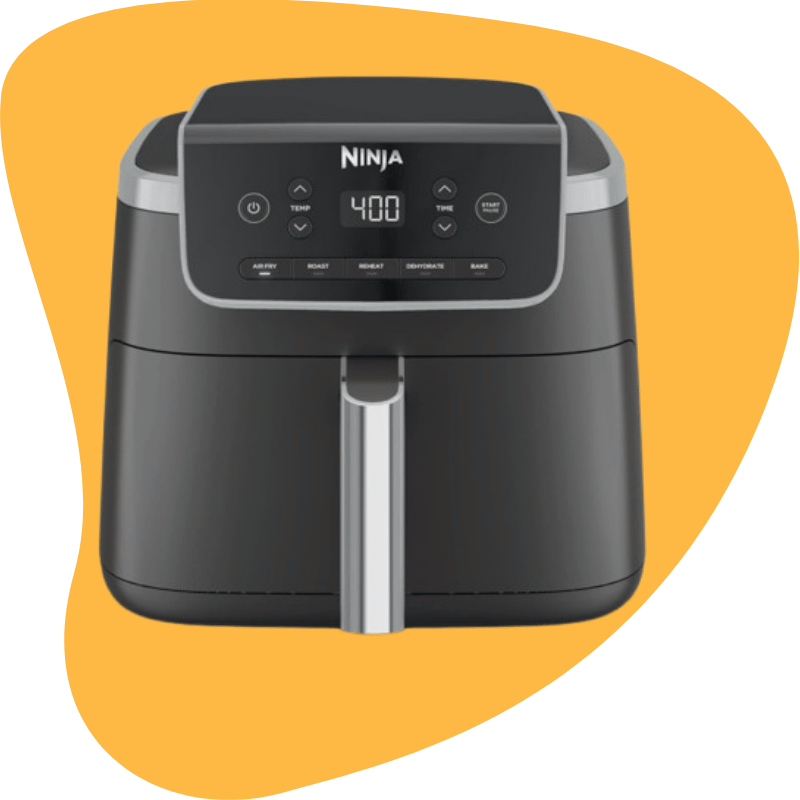
Ninja Air Fryer Pro 5-in-1 — 5 QT | Air Fry, Bake, Roast, Reheat & Dehydrate
Compact 5-quart air fryer that uses Air Crisp Technology (up to ~400°F) to deliver crispy, low-oil results and fits up to ~4 lbs of fries.
Five versatile functions — Air Fry, Bake, Roast, Reheat, and Dehydrate — with a nonstick basket and crisper plate for easy cleanup (dishwasher-safe).
Countertop-ready with intuitive touch controls and strong performance (≈1750W); ideal for small families, meal prep, and quick weeknight meals.

Air Fryer Model B — Best for Families / Dual-Zone: Philips Series 3000 Dual Basket
- Why it’s a family favorite: The dual-basket design lets you cook two items at different times or temps simultaneously — e.g., pork-rind crusted fish in one basket and roasted broccoli in the other. Reviewers praise its even cooking, quiet fan, and large single drawer in XL versions.
- Why it’s perfect for low carb air fryer meal building:
- Dual baskets mean no compromise: protein and sides can have separate cook profiles — big win for multi-component keto dinners.
- Large capacity versions give family-style output without poor crisping from overcrowding.
- Quick cooking examples that shine:
- Dual meal: chicken thighs (probe recommended) in one basket, zucchini fries in the other — both finish when you want them to.
- Big batch cheese crisps on one side while reheating meat leftovers on the other.
- Pros:
- Two independent baskets; great for family dinners.
- Even heating and easy cleanup on many models.
- Generally quiet operation and helpful presets.
- Cons:
- Larger footprint — needs counter space.
- Slightly more expensive than single-basket midrange units.
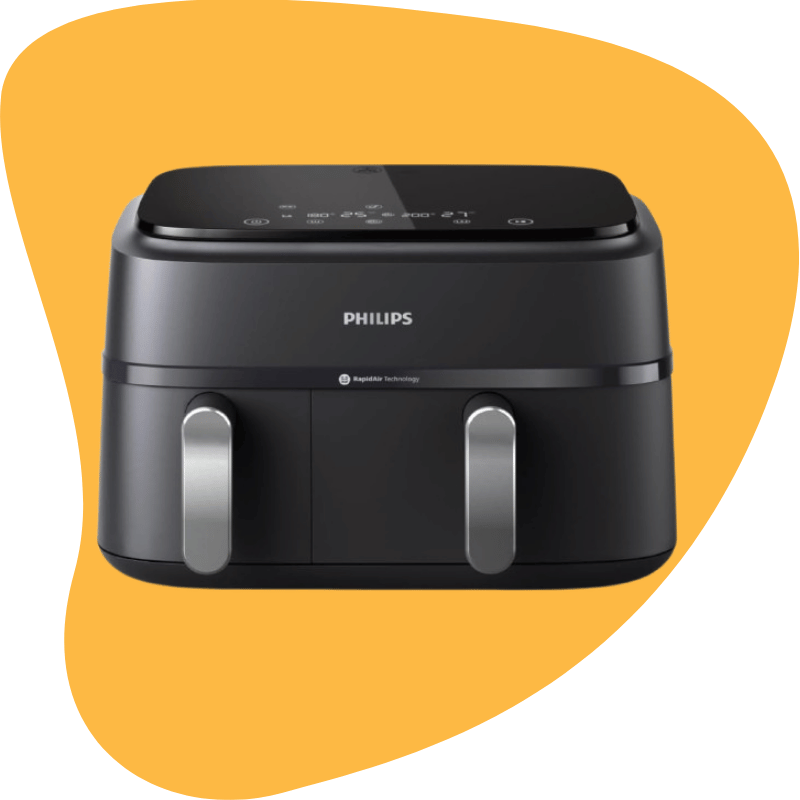
Philips Dual Basket Air Fryer 3000 Series — 8-in-1 | 9.5 qt
Two independent drawers (large + small) let you cook mains and sides at once — the Auto-Sync/Time function synchronizes cooking so everything finishes together.
RapidAir Plus technology delivers crispy results with up to 90% less fat vs. deep frying; 8-in-1 presets and HomeID/NutriU recipe support make meal prep easy.
Touchscreen controls and dishwasher-safe removable parts (typical specs list ~9.5 qt capacity and ~2850W) — great for family meals and versatile weeknight cooking.

Air Fryer Model C — Best Budget Pick: Instant / Vortex family or compact Cosori options
- Why budget models are worth considering: Not everyone wants to spend premium money — and several budget or value lines now deliver crisp and reliable performance at a lower price. Tests show that well-priced models like Instant Vortex and certain Cosori compact fryers offer good heat distribution and cleanability for everyday low carb air fryer use.
- Why this matters for low carb air fryer cooks:
- If your primary need is snacks (cheese crisps, small tenders, quick veg sides), a budget model can handle it without breaking the bank.
- Many budget models still reach temperatures that brown almond-flour coatings well.
- Quick cooking examples that shine:
- Frozen low-carb chicken tenders: 375–400°F for 10–14 min — crispy result with minimal oil.
- Broccoli/parmesan bites: roast at 375°F for 8–12 min for caramelized edges.
- Pros:
- Great value for occasional to regular use.
- Smaller / compact footprints that fit tight kitchens.
- Often, simple dials or intuitive touch panels.
- Cons:
- Might lack advanced features (probe, dehydrate).
- Some budget units use lower wattage — slower on large batches.
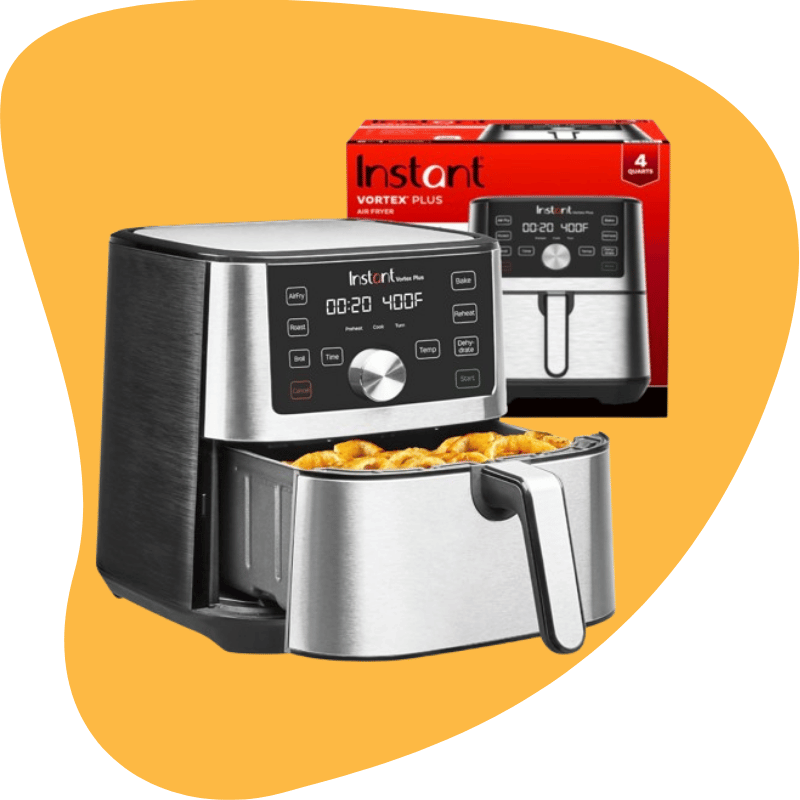
Instant Pot Vortex Plus 4-QT Air Fryer — 6-in-1 EvenCrisp™ Mini (Stainless Steel)
Compact 4-quart air fryer that uses EvenCrisp™ tech to deliver crispy, golden results with far less oil.
Six cooking modes — air fry, bake, roast, broil, dehydrate, and reheat — with one-touch/custom programs and fast (little-to-no) preheating.
Small footprint for countertops, includes customizable presets and access to 100+ in-app recipes for easy meal ideas.

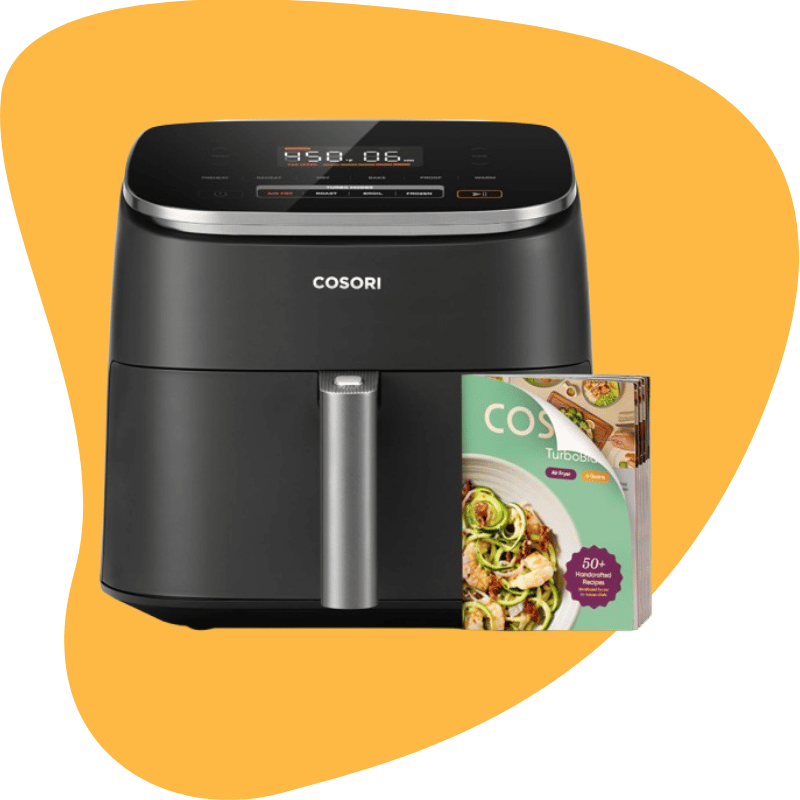
COSORI TurboBlaze 6-Qt Air Fryer — 9-in-1, 90–450°F, Premium Ceramic Coating (120V / 1,725W)
Compact, family-sized 6-quart TurboBlaze air fryer with 9 cooking functions and 5 fan speeds for faster, more even results.
Precise 90–450°F temperature control, premium ceramic-coated nonstick basket & crisper plate (dishwasher-safe), and a brand claim of up to 95% less oil vs. deep frying.
DC motor design cooks up to 46% faster than some older AC models, features an angled control panel for easy viewing, and runs on 120V / 1,725W — ideal for quick weeknight meals and meal prep.

Air Fryer Model D — Best High-Capacity / Tower: Cosori Turbo Tower / TurboBlaze / Tower Pro
- Why tower / high-capacity models stand out: Tower designs stack multiple chambers or provide large vertical capacity to cook a lot of food while maintaining airflow. Recent tower reviews praise consistent results and large family capacity — great when you want to batch-cook low-carb sides and proteins simultaneously.
- Why this is great for low carb air fryer meal prep:
- Large capacity means fewer repeated batches for family meals or meal prep containers.
- Many tower designs include multi-function presets (air fry, roast, dehydrate), which are handy for making kale chips, jerky, and large trays of roasted cauliflower.
- Quick cooking examples that shine:
- Meal-prep: two racks of chicken thighs + one drawer of roasted cauliflower in a single session — minimal cycling.
- Big batch pork-rind crusted fish fillets for lunches (freeze/reheat).
- Pros:
- Very large capacity for families and batch-cooking.
- Fast, consistent cooking across tiers when tested properly.
- Good feature set on premium models.
- Cons:
- Larger footprint and higher price.
- Vertical models can be pricier; watch for hotspots in cheaper tower designs.
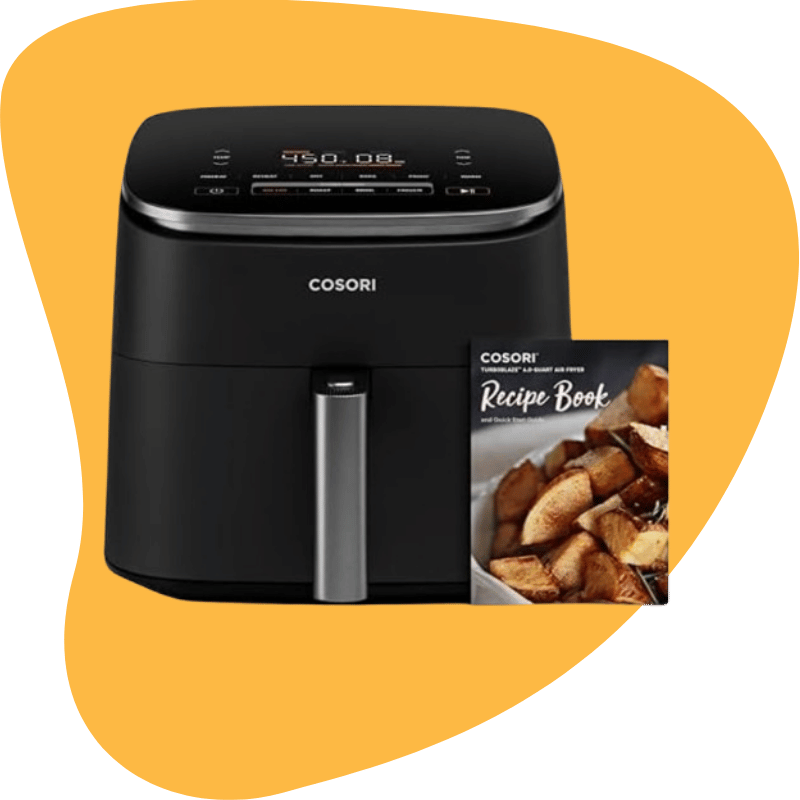
COSORI TurboBlaze 6.0-Quart Air Fryer — 9-in-1, TurboBlaze DC Motor, 6.0 qt (Compact Family Size)
Compact 6.0-quart air fryer with TurboBlaze DC motor that cooks faster and offers 9 functions (Air Fry, Roast, Bake, Broil, Dehydrate, Proof, Reheat, Frozen, Keep Warm).
Precise 90–450°F range, 5 fan speeds, and a 1,725W-rated motor for quick, even crisping; nonstick basket and dishwasher-safe parts for easy cleanup.
Often sold in bundles with 100-pack square disposable liners (7.9″ unbleached, up to ~465°F) for low-mess cooking — great for family meals and meal prep.

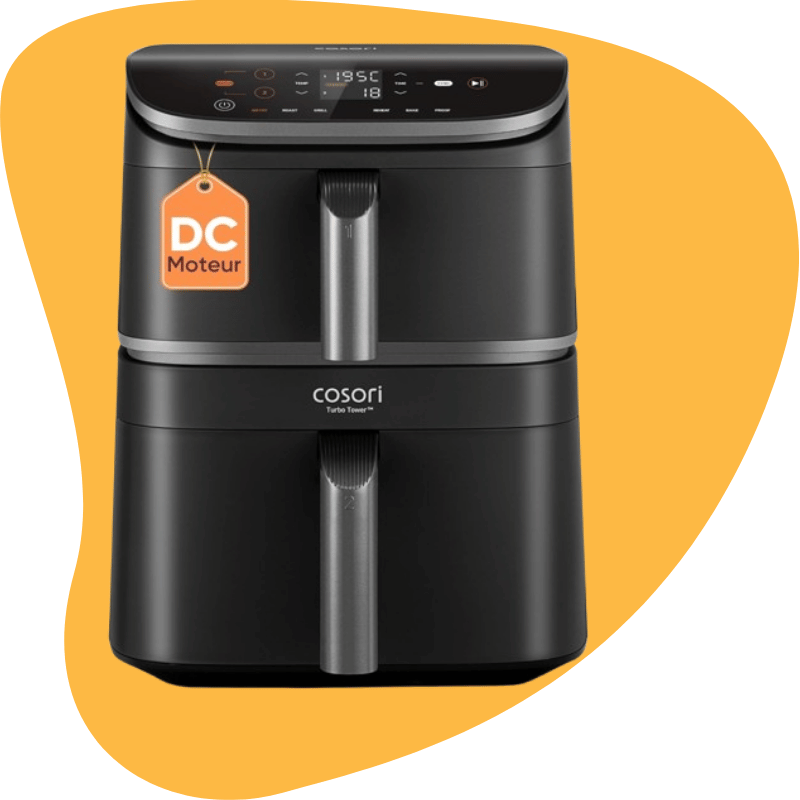
COSORI Turbo Tower 10.8L Dual-Drawer Air Fryer — 3-Level Stackable, 6-in-1 (Turbo Tower)
Vertically stacked dual-drawer air fryer with a total 10.8 L capacity (large bottom + smaller top) so you can cook mains and sides at once while saving countertop space.
Features three cooking levels and multiple presets (Air Fry, Roast, Bake, Grill/Reheat, Dehydrate/Proof — varies by model), with drawers that can run independently or be synced for one-step meals.
Space-saving design (about 41% less wide than some traditional double air-fryer footprints), dishwasher-safe removable parts, and a ceramic nonstick surface for easier cleanup.

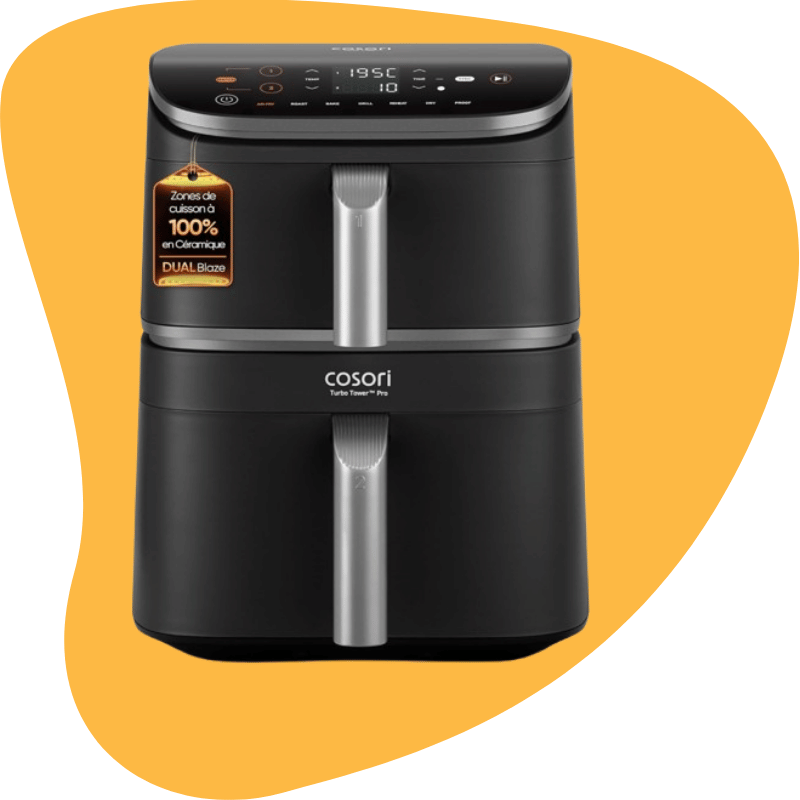
COSORI Turbo Tower Pro — 10.8 L Dual-Drawer Air Fryer (Stacked Design, 3-Level Cooking, TurboBlaze)
Compact, space-saving stacked air fryer with a total 10.8 L capacity (≈4.3 L top + 6.5 L bottom) so you can cook mains and sides at once.
Three cooking levels (includes a grate to create a third layer) with multi-function presets — air fry, bake, roast, grill, reheat, and proof — plus Match/Sync app features to copy or synchronize settings.
TurboBlaze multi-speed airflow and 100% ceramic nonstick baskets deliver fast, even crisping with dishwasher-safe parts and manufacturer-claimed energy savings (up to ~68% vs. a conventional oven).

Air Fryer Model E — Best for Small Kitchens / Singles: Ninja AF101 / AF141 or compact Instant Vortex Mini
- Why compact models deserve a spot: Small, well-designed fryers can outperform larger clunky units for single-serve meals and snacks— and they’re perfect if counter real estate is limited. Testers consistently recommend compact Ninjas and a few small Instant/Cosori units for solo cooks.
- Why a compact low carb air fryer is useful for keto:
- Single-serve batches mean you avoid waste and can re-crisp leftovers quickly.
- Small baskets encourage single layers, which maximizes crisping for delicate low carb breadings and cheese crisps.
- Quick cooking examples that shine:
- Single steak or two chicken thighs: sear + finish in a compact fryer for great texture.
- Cheese crisps and small veggie sides without the oven.
- Pros:
- Small footprint; fast heat up.
- Often very affordable and easy to stow away.
- Surprisingly capable for small meals.
- Cons:
- Limited batch size — you’ll run multiple rounds for more than 1–2 people.
- Some compact models have higher noise-to-performance ratios.
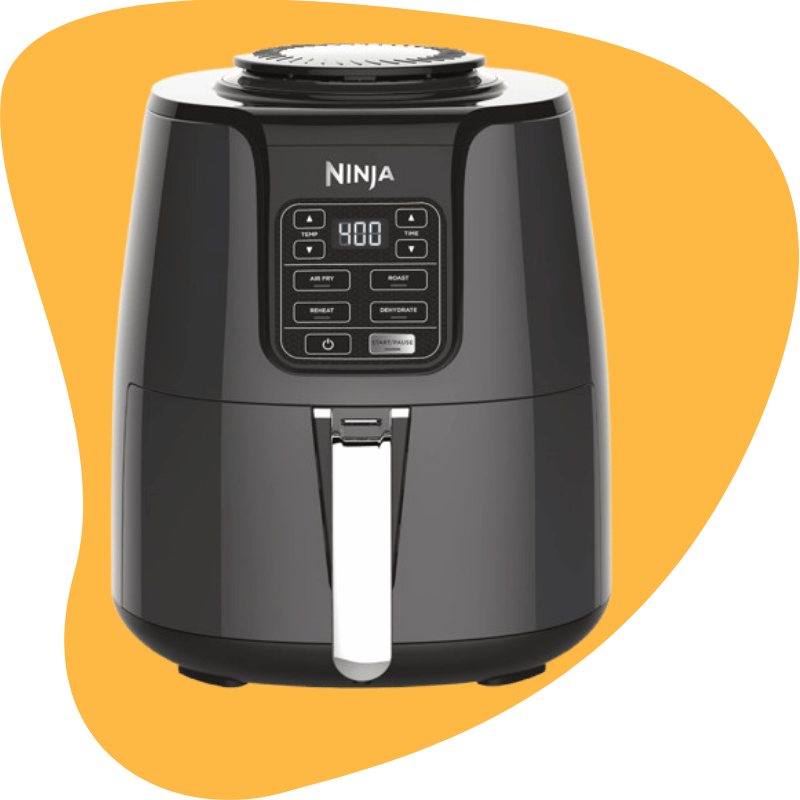
Ninja Air Fryer AF101 — 4-Quart Compact Air Fryer (Air Fry, Roast, Bake, Reheat & Dehydrate)
Compact 4-quart air fryer with multiple one-touch functions (Air Fry, Roast, Bake, Reheat, Dehydrate) for quick, low-oil cooking.
Ceramic nonstick basket (dishwasher-safe), 1550W power, fits up to ~2 lb of fries — small footprint ideal for countertops or tight kitchens.
Well-suited for singles/small families and frequently recommended in small-air-fryer roundups for its performance and easy cleanup.

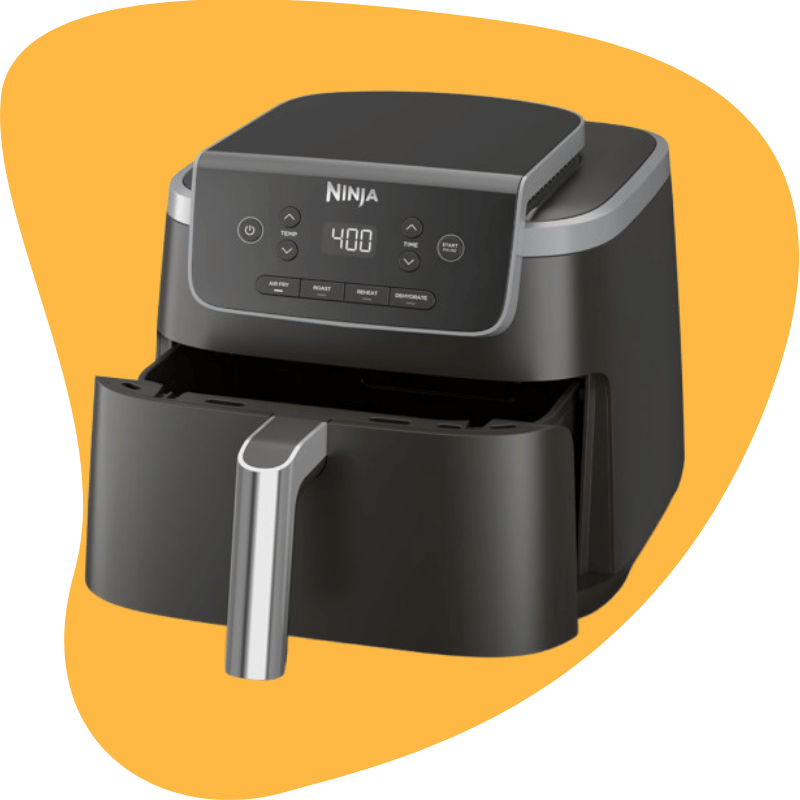
Ninja Air Fryer Pro AF141 — 4-in-1 Air Fryer, 5-Quart, Air Crisp up to 400°F
Compact 5-quart air fryer with Air Crisp technology and four functions — Air Fry, Roast, Reheat, and Dehydrate — for crispy, low-oil results.
Large ceramic-coated nonstick basket + crisper plate fits up to 4 lb of French fries (or ~5 lb wings) and reaches 400°F for fast browning.
Dishwasher-safe parts and simple controls make it ideal for small families and quick weeknight meals; independent reviews call it a solid compact 5-qt performer.

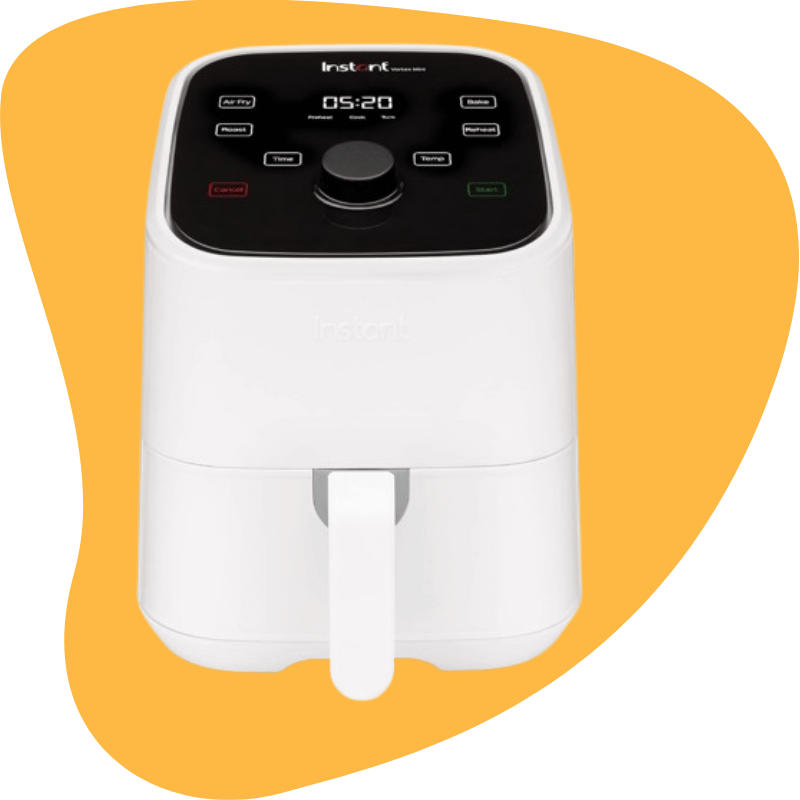
Instant Pot Vortex Mini 2-Quart Air Fryer — 4-in-1 (Air Fry, Bake, Roast, Reheat) — Dishwasher-Safe Basket, 120–400°F
Compact 2-quart air fryer that crisps, bakes, roasts, and reheats — perfect for singles, dorms, or small kitchens.
Features: EvenCrisp airflow for golden results, a 120–400°F temperature range, and little-to-no preheating for fast, easy meals.
Nonstick basket and tray are dishwasher-safe for easy cleanup, and the unit connects to 100+ in-app recipes to spark ideas.

Comparison Table: Quick specs
Below is a compact comparison you can scan. Use this as a shopping checklist — match the low carb air fryer features to how you cook.
- Ninja Air Fryer Pro (Best overall)
- Capacity: ~4–5 qt (mid) · Power: high (e.g., ~1750W on some Ninja Pro models) · Best for: crisping + everyday low-carb dinners.
- Philips Series 3000 Dual Basket (Best for families)
- Capacity: dual baskets / XL drawer options · Power: moderate–high · Best for: family meals, two dishes at once.
- Instant Vortex / Instant family (Best budget pick)
- Capacity: 4–6 qt typical · Power: midrange · Best for: value buyers, snacks & regular low-carb meals.
- Cosori Turbo Tower / TurboBlaze (Best high-capacity / tower)
- Capacity: large (multi-liter / stacked) · Power: high · Best for: meal prep, families, big batches.
- Ninja AF101 / AF141 or Instant Vortex Mini (Best for singles)
- Capacity: 2–5 qt compact · Power: lower to mid · Best for: single cooks, small kitchens.
Quick buying tip: if you plan to make a lot of almond-flour bakes and keto breads, favor oven-style or larger models with racks. If you mostly want crisp sides and proteins, a basket-style low carb air fryer with strong wattage is the better match.
Low-Carb Air Fryer Recipes & Techniques
If you own a low carb air fryer, this is where the magic happens: crunchy, satisfying dishes that keep carbs low and flavor high. Below are detailed, easy-to-follow recipes and techniques tailored for keto and low-carb cooks — each with temps, times, tips, and fail-safe swaps so you get crispy results every time.
Zucchini Fries and Chips — Almond Flour Coating
Why it works: Zucchini has the right water content and shape for fries; almond flour plus a little Parmesan seals and crisps beautifully in a low carb air fryer. (7, 8)
Ingredients (2 servings)
- 2 medium zucchini
- 1 large egg (or 2 egg whites) — beaten
- ½ cup almond flour
- ¼ cup grated Parmesan (optional, for extra crisp)
- 1 tsp Italian seasoning
- ½ tsp garlic powder
- Salt & pepper to taste
- Light spray of olive oil or avocado oil
Method
- Slice zucchini into ¼–½” sticks or very thin rounds for chips. Pat dry with paper towels — removing surface moisture is essential.
- Combine almond flour, Parmesan, and seasonings in a shallow bowl.
- Dip zucchini in egg, then press into the almond flour mix so each piece is well coated. Shake off excess.
- Preheat your low carb air fryer to 400°F (200°C) for 3–4 minutes.
- Place in a single layer in the basket — don’t overcrowd. Lightly mist with oil.
- Air-fry 12–15 minutes for fries (flip halfway), or 8–10 minutes for thin chips (shake halfway) until golden and crisp.
- Remove to a rack for 2 minutes (crisping continues off heat), then serve.
Pro tips
- Press the coating onto the zucchini so it adheres; a second dip into the egg and coating for a thicker crust works well.
- For extra crunch, use a mix of almond flour + crushed pork rinds (50/50).
- Avoid soaking zucchini — it releases water and ruins crisping.
Almond Flour Chicken Tenders
Why it works: Almond flour gives a golden, nutty crunch and keeps carbs low; air frying sets the coating fast so the chicken stays juicy. (9, 10)
Ingredients (4 servings)
- 1 lb chicken tenders or thin strips
- 2 large eggs — beaten (or 1 cup buttermilk for extra tenderness)
- 1 ¼ cups almond flour
- ½ cup crushed pork rinds (optional, for extra crunch)
- 1 tsp smoked paprika
- 1 tsp garlic powder
- Salt & pepper
- Cooking spray (avocado or olive oil)
Method
- Pat chicken dry and season lightly with salt & pepper.
- Mix almond flour, crushed pork rinds (if using), and spices in a shallow bowl.
- Dip each tender in egg, then press into the flour mix. For a thicker crust, repeat the egg → coating once.
- Preheat low carb air fryer to 400°F (200°C).
- Arrange in a single layer; spray tops lightly.
- Cook 12–16 minutes, flipping once at the halfway point. Internal temp should reach 165°F (74°C).
- Rest 2–3 minutes before serving to lock in juices.
Pro tips
- If tenders brown too quickly, lower the temperature to 375°F and add a few minutes.
- Use a meat probe for larger pieces to avoid overcooking.
- For buffalo style, toss hot tenders in a little butter + hot sauce after cooking.
Parmesan Crispy Broccoli / Cauliflower
Why it works: The combo of grated Parmesan and a quick air-fry produces caramelized edges and crunchy nooks. Great as a side or snack. (11, 12)
Ingredients (2–3 servings)
- 1 head broccoli (or cauliflower) — cut into small florets
- 2 tbsp olive oil
- ½ cup grated Parmesan
- 1 tsp garlic powder
- Salt & pepper
Method
- Toss florets with oil, garlic powder, salt, and Parmesan until evenly coated. Press the cheese into crevices so it sticks.
- Preheat low carb air fryer to 375°F (190°C).
- Place florets in a single layer (may need batches).
- Air-fry 8–12 minutes, shaking or turning halfway, until edges brown and cheese crisps.
- Serve immediately — sogginess increases if left too long.
Variations
- Add a sprinkle of lemon zest or red pepper flakes after cooking.
- For a breadcrumb feel without carbs, toss with crushed pork rinds in place of some Parmesan.
Keto “Breaded” Fish Fillets (Pork Rind Crust)
Why it works: Crushed pork rinds replicate the crunch of breadcrumbs with virtually zero carbs; air frying gives an even, flaky crust. (13, 14, 15)
Ingredients (2–3 servings)
- 12–16 oz white fish fillets (tilapia, cod, haddock) — cut into portions
- 2 eggs — beaten (or mayo for no-egg binding)
- 1 cup crushed pork rinds
- ½ cup Parmesan (optional)
- 1 tsp paprika, ½ tsp garlic powder, salt & pepper
- Lemon wedges for serving
Method
- Pat fish dry. Season with salt and pepper.
- Mix crushed pork rinds, Parmesan, and spices.
- Dip the fish in egg, then press into the pork rind mix until coated.
- Preheat low carb air fryer to 390–400°F (200–200°C).
- Place fillets on a rack or single layer; lightly spray with oil.
- Air-fry 10–14 minutes, depending on thickness, flipping halfway. Fish should flake easily.
- Serve with lemon and an herb aioli if desired.
Pro tips
- For extra crunch, refrigerate coated fillets 10–15 minutes before cooking to set the crust.
- If the fish is delicate, use parchment rounds under each piece to prevent sticking (ensure air can still circulate).
Fat-Forward Keto Sides: Avocado Fries, Cheese Crisps
Avocado Fries (great creamy/crisp contrast)
- Slice firm avocados into wedges; toss in beaten egg or mayo, then coat with a mix of almond flour + Parmesan or crushed pork rinds.
- Air-fry 350–375°F (175–190°C) for 6–9 minutes, flipping once. Watch closely—avocado softens quickly.
Cheese Crisps (zero-carb snack)
- Place small mounds (1 tbsp) of grated cheddar or Parmesan on parchment or directly on the basket (if your model allows).
- Air-fry 350–370°F (175–185°C) for 4–6 minutes until golden and set. Cool completely to crisp.
Notes
- Cheese crisps can be used as “chips” or crumbled as salad toppers.
- Avocado fries are best eaten fresh — their creamy interior contrasts with the crunchy coating. (16)
Meal Prep & Batch Cooking Tips
Using a low carb air fryer for meal prep is smart — you get crisp textures when you reheat and save time during the week.
Batch-cooking workflow
- Cook proteins and veggies separately. Proteins (chicken, fish) keep juicier if cooked apart from vegetable sides.
- Cool properly before storing. Let items cool 10–15 minutes on a rack before refrigerating to prevent sogginess.
- Flash-crisp when reheating. Reheat at 350–375°F for 3–6 minutes to restore crispness — the low carb air fryer outperforms microwaves for texture.
Storage & reheating
- Refrigerator: Store 3–4 days in an airtight container.
- Freezer: Freeze portions on a tray, then bag; reheat from frozen at 350°F for 8–12 minutes (time varies by size).
- Re-crisp tip: Use a short high-temp blast (e.g., 400°F × 2–3 min) at the end to re-crisp coatings.
Time-saving tips
- Make double batches: Freeze half for quick lunches.
- Use parchment rounds (safe temp permitting) for sticky cheeses and easy transfer.
- Label containers with cook & freeze dates to manage freshness.
Air Fryer vs Conventional Oven for Keto Meals
If you cook keto or low-carb most nights, you’ve probably wondered whether your low carb air fryer is a genuine time-and-taste win compared with the oven — and the answer depends on what you’re cooking and how much you’re cooking. Below, I break down the real-world differences in energy & speed, capacity & portions, and texture & taste, then give practical rules so you can pick the right tool for every low-carb meal.
Energy Use & Cooking Speed Comparison
Short version: For small-to-medium portions, a low carb air fryer usually uses less energy and cooks faster than a full-size oven — but for very large batches, the oven can be more efficient per pound.
Why: Air fryers have smaller cavities and intense fan-driven circulation, so they heat up fast and reach cooking temps quickly. Multiple energy analyses and consumer guidance conclude that air fryers are often cheaper to run for one or two servings (Energy Saving Trust) and can lower total energy used because cook times are shorter. (17)
Key facts:
- Smaller space to heat = faster preheat and cook times.
- High wattage but short runtime = lower total kWh for single meals.
- Oven wins for very large roasts or multiple sheet pans because you’re heating one big insulated cavity instead of repeating smaller batches. (18, 19)
Practical tips to save energy when using a low carb air fryer:
- Preheat only when a recipe needs it (3–5 minutes is usually enough).
- Group small items together (batch smartly) so you use residual heat.
- Use the air fryer for one-pan dinners, snacks, and reheats; use the oven for big family trays.
Quick comparison (energy & time pros/cons):
- Air fryer pros: faster for 1–4 servings, lower kWh per small meal, better at quick re-crisps.
- Oven pros: more efficient for large volumes, better for long, slow roasts, or multiple dishes at once.
Capacity & Meal Portions
Short version: The oven is a volume champion; the low carb air fryer is a speed champion. Which to use depends on plate size and batch goals.
When to use your low carb air fryer:
- Single-serve or 2-person dinners (chicken tenders + a veg side).
- Reheating and re-crisping leftovers (air fryers restore texture far better than microwaves).
- Snacks and small batches (cheese crisps, zucchini chips).
When to use the oven:
- Holiday roasts, sheet-pan dinners for 4+, or when you need to bake low-carb breads/large casseroles.
- Multi-rack bakes (bread, big frittatas, several trays of roasted veg).
Capacity considerations you’ll actually notice:
Basket-style air fryers are great for crisping but limit surface area; oven-style models (or larger multi-drawer units) blur the line a bit. Recent reviews point out that larger air-fryer and tower models can approach oven capacity — but check real internal volumes, not just marketing names.
Practical rule of thumb:
If you regularly cook for 3+ people or batch-prep a week’s lunches in one session, favor the oven or a large multi-drawer/tower air fryer. For everything else, the low carb air fryer will be faster and more convenient.
Texture & Taste Differences
Short version: Air fryers excel at edge crisp and surface browning; ovens are better at even, slow baking and large-scale caramelization. Both can make delicious keto meals — they just do different things well.
What’s happening under the hood:
- Crispness is a dehydration and Maillard-reaction story: quick, hot airflow removes surface moisture fast and encourages browning, which is why almond-flour coatings, pork-rind crusts, and cheese crisps get so good in a low carb air fryer. Science explains that dehydration and surface temperature drive crisp texture; air fryers concentrate that effect. (20, 21)
- Moisture retention: ovens (especially when used at lower temps) can produce juicier interiors for thicker roasts or slow-baked low-carb breads. Air fryers can dry the interior if you use too high a temp for too long — but they also render fats beautifully (great for crispy chicken skin or bacon) if you use short high-heat finishes. (22)
Food-by-food guidance (what to pick for the best texture):
- Use the air fryer for:
- Almond-flour chicken tenders, cheese crisps, zucchini chips, bacon, thin fish fillets, and re-crisping leftovers.
- Use the oven for:
- Keto breads, large casseroles, slow-roasted pork shoulder, and multi-tray batch roasts.
- Hybrid approach: Sear or crisp in the air fryer, then finish gently in the oven (or reverse: roast in oven, finish in air fryer for crisp edges).
Practical texture hacks to get the best of both worlds:
- Two-stage cooking: start at a moderate temp to cook through, finish at a higher heat to crisp.
- Use a meat probe: avoid overcooking thicker proteins (probe & rest = juicy interior + crisp exterior).
- Single layer & preheat: ensure airflow and a hot starting surface for immediate browning.
Troubleshooting, Safety & Maintenance
Owning a low carb air fryer is great — until it smokes, sticks, or gives off a strange smell. Below is a friendly, highly practical playbook: common problems and quick fixes, cleaning & non-stick safety, and sensible steps to reduce chemical risks like acrylamide. Use the checklists, and your fryer will reward you with crisp, safe food for years.
Common Problems & Fixes
Problem: Your fryer is smoking
- Likely causes:
- Fat or oil dripped onto the heating element.
- Food debris or burnt crumbs on the element or basket.
- Cooking at too high a temperature for very fatty foods.
- Quick fixes:
- Turn off & unplug, let cool, then inspect the heating element and basket. Remove any visible grease with a soft brush and mild soapy water. (23, 24)
- Trim excessive fat from meats or use a drip tray below the rack.
- Lower the temperature 10–20°F and extend cook time for fatty cuts; finish with a short high-heat blast to crisp.
- Prevention:
- Clean the heating element and basket after every few uses (see cleaning schedule below). Use a drip tray for bacon and fatty roasts.
Problem: Food turns out soggy or unevenly cooked
- Likely causes:
- Overcrowded basket (air can’t circulate).
- Wet or undried ingredients (water = steam = soggy).
- Uneven piece sizing.
- Fixes:
- Cook in a single layer; work in batches.
- Pat ingredients dry before breading/coating.
- Cut pieces uniformly; shake or flip partway through.
- Pro tip: preheat the low carb air fryer 3–4 minutes — a hot start seals coatings and improves crisp.
Problem: Unit won’t start / touchscreen unresponsive
- Likely causes:
- Power/plug issue, internal safety cut-off, or stuck button.
- Fixes:
- Unplug for 60 seconds, plug into a different outlet, and retry.
- Check the basket/drawer is fully seated — many models won’t run if not locked.
- If persistent, contact the manufacturer support (warranty/repair). Always note the serial & model when calling.
Problem: Burning smell or off-flavor
- Likely causes:
- Old burned-on crumbs, grease build-up, or plastic residue from new units.
- Fixes:
- Deep clean (see 7.2) and run an “empty” cycle with a bowl of warm water and a splash of vinegar to deodorize.
Cleaning, Non-Stick Coatings & Safety Concerns
Daily / after-each-use cleaning (fast & effective)
- Let the unit cool, then:
- Remove basket/trays and wash with warm soapy water (or dishwasher if manufacturer allows).
- Wipe the interior with a damp cloth; gently clean the heating element with a soft brush if needed.
- Dry completely before reassembly. Regular cleaning prevents smoke, off-flavors, and fire risk.
Weekly/monthly deeper clean
- Soak stubborn crumbs in warm soapy water; scrub with a soft, non-abrasive brush.
- Wipe interior walls; remove grease from vents.
- If the manufacturer suggests, run a vinegar + water cycle to loosen residue, then wash. Tom’s Guide and appliance experts recommend periodic deep cleans to preserve performance and safety.
Non-stick coatings & “forever chemicals” (PFAS/PFOS)
- What to know:
- Most modern non-stick coatings are PFOA-free, but some coatings may still contain other PFAS-like chemistries. If you’re concerned, consider PFAS-free or ceramic-lined models, stainless-steel inserts, or glass-front oven-style fryers. Homes & Gardens and other buyers’ guides list PFAS-free options. (25, 26)
- Safety tips:
What to avoid
- Abrasive scouring pads and steel wool that damage coatings.
- Harsh chemical cleaners, unless the manual allows them.
- Placing unapproved metal utensils or foil directly against the non-stick surface (check model guidance).
Replacement parts
Keep an eye on wear: warped baskets, peeling coatings, or frayed cords are signs to replace parts or retire the unit. Many brands sell replacement baskets and trays — check manufacturer support.
Avoiding Acrylamide & Food Safety Notes
What is acrylamide, and why does it matter
Acrylamide is a chemical that can form in starchy plant foods (potatoes, bread, cereals) during high-temperature cooking like frying, roasting, or baking. Regulators (FDA) advise that high-temperature cooking increases acrylamide formation and recommend practical steps to reduce exposure. (29, 30)
Practical ways to reduce acrylamide when using your low carb air fryer
- Avoid over-browning starchy foods — cook to golden, not dark brown. The darker the food, the higher the acrylamide tendency.
- Lower the temperature and extend cooking time for potato products (e.g., roast at a slightly lower temp and longer time). FDA guidance suggests that lowering frying temperatures can reduce acrylamide.
- Prefer lower-starch low-carb choices (zucchini, cauliflower, cheese crisps) more often — meats and cheeses are not sources of acrylamide.
Food-safety basics (USDA / FSIS guidance)
- Always use a thermometer: check internal temps to ensure safety (e.g., poultry 165°F / 74°C). A probe thermometer is the most reliable method and essential when air-frying thicker cuts. (31, 32)
- Follow safe handling: avoid cross-contamination, refrigerate cooked foods promptly, and reheat leftovers to at least 165°F. (33)
Smoke & chemical exposure
Occasional light smoke is common with very fatty foods, but persistent heavy smoking or burning odors mean you should stop cooking, clean the unit, and inspect the element. Persistent heavy smoke can produce unpleasant compounds; regular cleaning minimizes this.
Meal Plans & Weekly Menu Ideas for Low-Carb Air-Fryer Users
If you want to eat low carb without spending hours at the stove, your low carb air fryer can be the MVP of the week. Below, I give you a practical 7-day menu built around the air fryer, a scaled grocery list, batch-cook and reheating rules, vegetarian swaps, and a quick prep plan so you spend less time cooking and more time enjoying crisp, satisfying meals.
Why build a week around the low carb air fryer?
- Faster cook times and great re-crisping for leftovers.
- Perfect for almond-flour and pork-rind coatings that need quick, dry heat to crisp.
- Saves energy and time for 1–4 people on weeknights. (34, 35)
7-Day Low-Carb Air-Fryer Weekly Menu (Dinner-focused; breakfast & lunch ideas included)
Notes: Portions target 1–2 people; scale up for families. Times assume a preheated low carb air fryer and mid-size (4–6 qt) basket. Swap lunches/breakfasts as you like — many dinners double as lunches.
Day 1 — Quick & Classic
- Breakfast: Greek yogurt + 2 tbsp crushed nuts + berries
- Lunch: Salad w/ air-fried salmon flakes (use leftover salmon)
- Dinner (Air fryer): Almond-flour chicken tenders + Parmesan broccoli (air-fried).
- Cook chicken 400°F × 12–15 min; broccoli 375°F × 10 min.
- Tip: Cook chicken first, keep warm, then do broccoli so both are hot together.
Day 2 — Fish & Greens
- Breakfast: Omelet with spinach & cheddar
- Lunch: Tuna salad stuffed avocado
- Dinner (Air fryer): Pork-rind-crusted fish + roasted green beans (air-fried).
- Fish 390–400°F × 10–14 min. Green beans 375°F × 8–10 min.
Day 3 — Comfort Night
- Breakfast: Chia pudding with cinnamon
- Lunch: Leftover chicken tenders + mixed greens
- Dinner (Air fryer): Air-fryer “fried” chicken thighs (skin on) + cauliflower mash.
- Sear/finish: 400°F × 8–12 min; use a meat probe to 165°F internal.
Day 4 — Veggie Heavy
- Breakfast: Cottage cheese + cucumber slices
- Lunch: Egg salad lettuce wraps (air-fryer bacon crumble)
- Dinner (Air fryer): Zucchini fries (almond-flour) + air-fried stuffed mushrooms.
- Zucchini fries 400°F × 12–15 min. Mushrooms 375°F × 8–10 min.
Day 5 — Seafood Night
- Breakfast: Smoothie (spinach, protein powder, almond milk)
- Lunch: Salmon & kale salad (from dinner leftovers)
- Dinner (Air fryer): Air-fryer salmon with lemon-herb rub + asparagus.
- Salmon 375–390°F × 8–10 min; asparagus 375°F × 6–8 min.
Day 6 — Snacky / Social
- Breakfast: Scrambled eggs + avocado
- Lunch: Leftover fish tacos in lettuce cups
- Dinner (Air fryer): Cheese crisps + buffalo wings + celery sticks.
- Wings 380–400°F × 20–25 min (flip halfway). Cheese crisps 350–370°F × 4–6 min.
Day 7 — Meal-Prep Sunday
- Breakfast: Egg muffins (bake in oven or air fryer tray)
- Lunch: Batch-made chicken & roasted veg bowls (reheat in air fryer)
- Dinner (Air fryer): Batch roast: chicken thighs + Brussels sprouts for weekly lunches.
- Roast chicken 390°F × 20–25 min (finish crisp at high temp).
Grocery List (base for the week — scale quantities)
- Proteins: chicken thighs/tenders, salmon fillets, white fish, eggs, bacon
- Veggies: zucchini, broccoli, cauliflower, asparagus, green beans, Brussels sprouts, mixed salad greens, avocados
- Pantry/coatings: almond flour, crushed pork rinds, grated Parmesan, olive oil spray/avocado oil, spices (paprika, garlic powder, Italian seasoning), mayo, mustard
- Extras: Greek yogurt, nuts, berries, leafy greens, cheese (cheddar/Parmesan), protein powder (optional)
Tip: Buy bulk frozen vegetables (cauliflower florets, green beans) for convenience and consistent air-fryer results.
Batch-Cooking & Prep Plan (Weekend session — 60–90 minutes)
- Proteins:
- Bake/air-fry a tray of chicken thighs (seasoned). Cool, portion into containers.
- Make a double batch of almond-flour chicken tenders and freeze half on sheet trays — transfer to bags. Reheat in an air fryer from frozen (8–12 min).
- Veggies:
- Roast cauliflower & Brussels sprouts in two batches. Store in fridge for quick reheats.
- Make a large bowl of salad greens (keep dressing separate).
- Snacks & extras:
- Make a sheet of cheese crisps and store airtight (they last several days).
- Hard-boil eggs for quick lunches.
- Label & date all containers; place frequently used items at the front for easy access.
Reheating rule: Re-crisp in the low carb air fryer at 350–375°F for 3–6 minutes — this restores texture far better than microwaves.
Vegetarian & Family Scaling Options
- Vegetarian swaps: Replace animal proteins with halloumi, tempeh, tofu pucks (marinated), or large portobello caps — all air-fry well. Use almond-flour coatings on tofu or halloumi for crunch.
- Scaling for family: Use a large-capacity or dual-basket low carb air fryer or cook in two batches to preserve crispness. Consider oven-style air fryers for larger trays.
Nutrition & Balance (practical guidance)
Aim to fill half your plate with non-starchy vegetables, one quarter with protein, and the rest with healthy fats — a simple visual plate approach endorsed by diabetes/nutrition organizations for balanced meals. This helps keep meals low-carb and nutrient-dense.
Accessories & Add-Ons that Improve Keto Cooking with a Low Carb Air Fryer
When you’re cooking keto or low-carb, the right accessories turn a good low carb air fryer into a brilliant one. They speed up cleanup, improve crisping, make batch-cooking easier, and help you hit perfect doneness without guessing. Below, I’ve grouped the most useful add-ons, explained why each matters for low-carb air fryer cooking, and given practical tips so you can pick the best versions.
Main accessories — what to buy and why
- Silicone liners/pots
- Why: cut cleanup time and catch cheese, nut flours, or sticky marinades. Good silicone liners with grooves can also lift food slightly to maintain airflow.
- Use for: messy batters, cheese crisps, and quick roasts where you’d rather lift a whole liner than scrub the basket.
- Cautions: flat or solid liners can reduce airflow and may change crisping times — prefer designs with vents or raised dimples for even cooking. Tests and guides recommend specific vented silicone pots or perforated liners for even results.
- Perforated parchment / air-fryer parchment rounds
- Why: single-use convenience for small items (crumbs won’t fall into the bottom) and easy transfer of delicate foods.
- Use for: cheese crisps (place on parchment and remove when cool), small cookies, or to stop delicate fish from sticking.
- Cautions: never place a loose sheet in an unheated fryer (it can fly into the element). Always weigh parchment down with food and follow your model’s temp limits. Expert Q&As and brand reps stress safety when using parchment and foil.
- Perforated metal trays / flat crisper sheets
- Why: give a flatter surface than a basket while still allowing airflow for even browning — ideal for almond-flour cookies, chicken tenders, or reheating.
- Use for: larger, flatter batches that need a stable base (keto bread slices, multiple cheese crisp mounds). Food & Wine and accessory roundups recommend crisper sheets for more versatile cooking.
- Multi-layer racks & extra shelves
- Why: increase capacity without stacking pieces directly on top of each other — great for batch meal prep.
- Use for: stacking chicken thighs, multiple trays of roasted veg, or dehydration batches. Ensure your model’s airflow works well with extra racks — some cheaper stacks can create hotspots.
- Meat probe / instant-read probe (built-in or separate)
- Why: eliminates guesswork for protein doneness — essential for thicker chops, roasts, or chicken thighs on keto. Many modern air-fryer models either include a probe or support one plugged in, which can auto-stop at a temperature. Tech reviews highlight probes as a major convenience feature for consistent results.
- Silicone molds & loaf pans (air-fryer safe)
- Why: make keto loaves, egg muffins, and crustless quiches simple — silicone tolerates high temps and releases easily. Verify the manufacturer’s safe temp range and choose LFGB or food-grade silicone. Guides on air-fryer-safe bakeware list ceramic, glass, metal, and silicone options.
- Skewers, rotisserie accessories & kebab racks
- Why: better airflow and even cooking for kebabs, halloumi, or shrimp — useful for protein variety. Some tower/oven-style models support rotisserie attachments.
- Oil mister & basting brush
- Why: light, even oiling, gives browning without drowning coatings — a spritz is better than pouring. Use a pump mister (no aerosol) for control when crisping almond-flour batters or finishing bacon.
- Tongs, basket lifters, silicone mitts & heat-proof grips
- Why: safe handling matters — tongs and mitts avoid burns and let you flip crisps and tenders without breaking them. Food & Wine suggests getting a good grip if you use the fryer daily.
- Drip trays & grease catchers
- Why: keep your unit smelling fresh and reduce smoke when rendering fatty cuts (bacon, pork belly). Place under racks when cooking high-fat items and empty often.
- Mesh liners & crisper baskets
- Why: allow airflow while containing small pieces (e.g., crushed pork-rind crumbs) — great for crispy particles that might otherwise fall through the basket holes.
Accessories that specifically help keto / low-carb cooking
- Reusable silicone muffin cups — perfect for egg muffins (high-fat breakfasts) and fat-forward mini quiches; avoid sticking and cut cleanup.
- Perforated pizza pan or small baking stone — makes crisp keto “fathead” pizzas or reheats almond-flour flatbreads evenly.
- Dehydrator trays or mesh — make kale chips, fruit leather with sugar-free blends, or jerky — excellent keto snack prep.
- Pork-rind crumb pounder / small food processor — grinds pork rinds to a breadcrumb consistency for that authentic crunchy crust with zero carbs.
Cleaning & safety add-ons
- Soft-bristle cleaning brush & microfiber cloths — remove stuck cheese and ground nuts from baskets without scratching nonstick coatings. Food & Wine’s cleaning guide emphasizes regular basket/coil cleaning to avoid grease build-up and smoke. (36)
- Replacement silicone basket liners or spare racks — swap while the other set is in the dishwasher to cut turnaround time.
- Drip tray liners — save time on scrubbing and reduce burnt grease residue.
Practical buying tips (quick checklist)
- Pick accessories labeled air-fryer safe or that explicitly list a temperature rating ≥ 430°F if you sear/finish at high temps.
- Prefer vented / perforated designs for anything placed under or around food to preserve airflow and crisping. (Solid mats are best for gooey batters, but they may require slightly longer cook times.)
- For meat probes: confirm that the probe cable and plug are rated for the fryer model, and that it’s designed to be left in when cooking (some are). Built-in probes that auto-stop at a set temp are especially convenient.
Tech Advisor - Don’t buy cheap coated pans that scratch easily — a scratched nonstick surface can trap burnt nut flours and change flavors.
Quick accessory combo for a keto starter pack (what I recommend)
- Perforated crisper tray (for even browning of almond-flour coatings).
- Reusable vented silicone pot (easy cleanup for cheese and nut flours).
- Meat probe (or a model with a built-in probe).
- Oil mister + silicone brush.
- Set of extra racks (if your model supports them) and a soft cleaning brush.
This kit covers crisping, baking, protein accuracy, minimal cleanup, and batch prep.
The Bottom Line
A low carb air fryer is one of those kitchen tools that makes sticking to a low-carb or keto plan easier and more delicious. It’s perfect for crisping, reheating, and creating satisfying, crunchy textures without the deep-fryer guilt. Choose the size that matches your household, prioritize build quality and cleaning ease, and use the recipe ideas above to get started — you’ll be amazed at how many fried favorites go low-carb with tiny swaps and an air fryer.
FAQs
Are air fryers healthy for a low carb air fryer diet?
Yes, because they use significantly less oil than deep-frying, a low carb air fryer lets you enjoy crisp textures with fewer added fats. (Cleveland Clinic: air frying reduces added oil).
Can I cook frozen low-carb items in a low carb air fryer?
Absolutely — frozen chicken tenders, meatballs, and veggie mixes crisp nicely. Increase the temperature slightly and add a couple of minutes to the cook time; shake the basket once or twice.
How much oil does a low carb air fryer use?
Often, only a teaspoon or light spray is enough for browning. For many recipes (cheese crisps, seasoned veggies), you can skip oil entirely.
Will an air fryer ruin the macros of my keto meal?
No — macros remain driven by your ingredients, not the cooking method. A low carb air fryer helps preserve proteins and reduces added oils, which commonly helps keep the fat and carb balance you want.
How do I avoid soggy low-carb fries in my low carb air fryer?
• Don’t overcrowd the basket.
• Dry ingredients thoroughly before breading.
• Preheat the air fryer and flip/shake halfway.
These simple steps produce crisp, golden results.


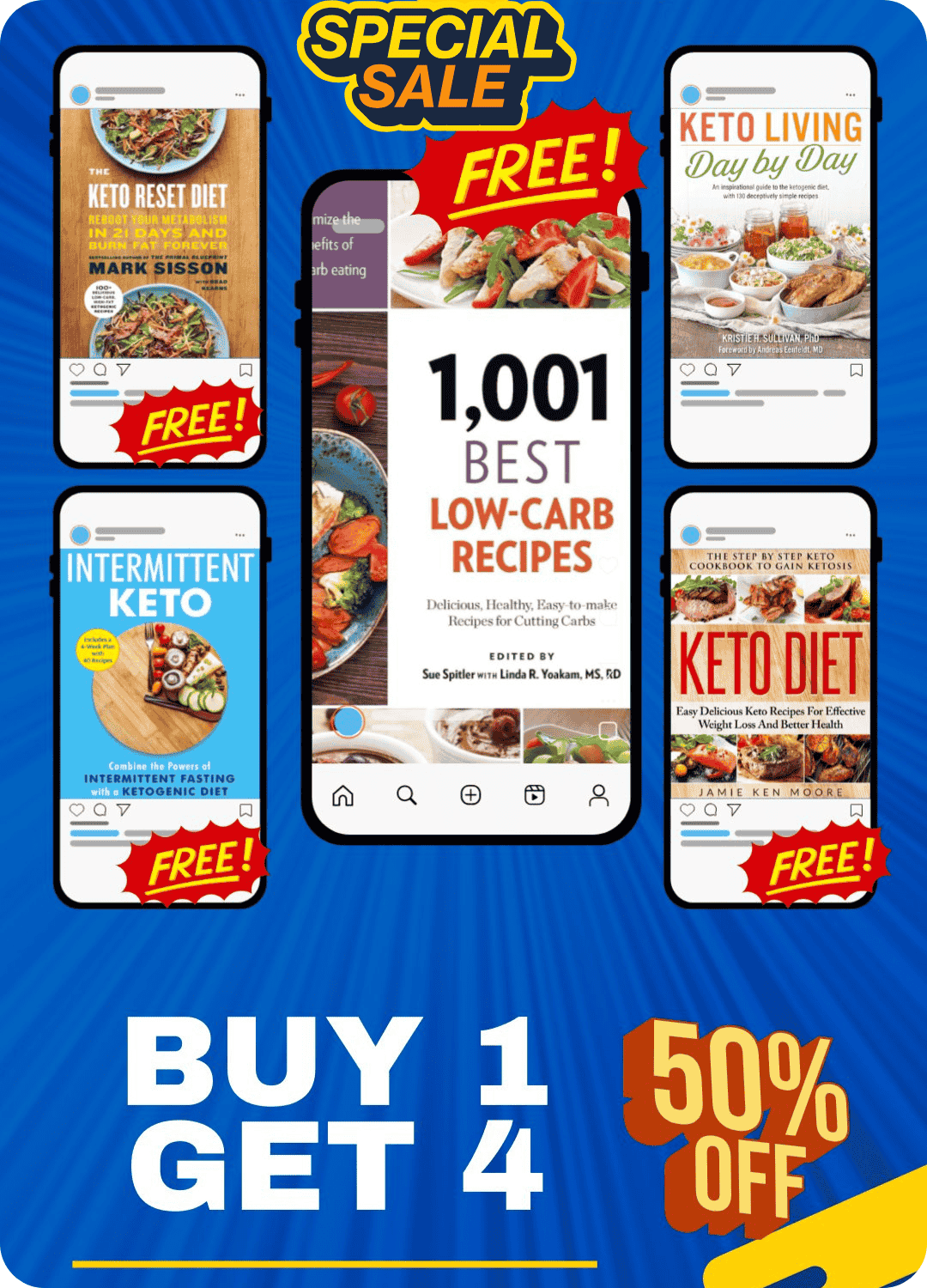
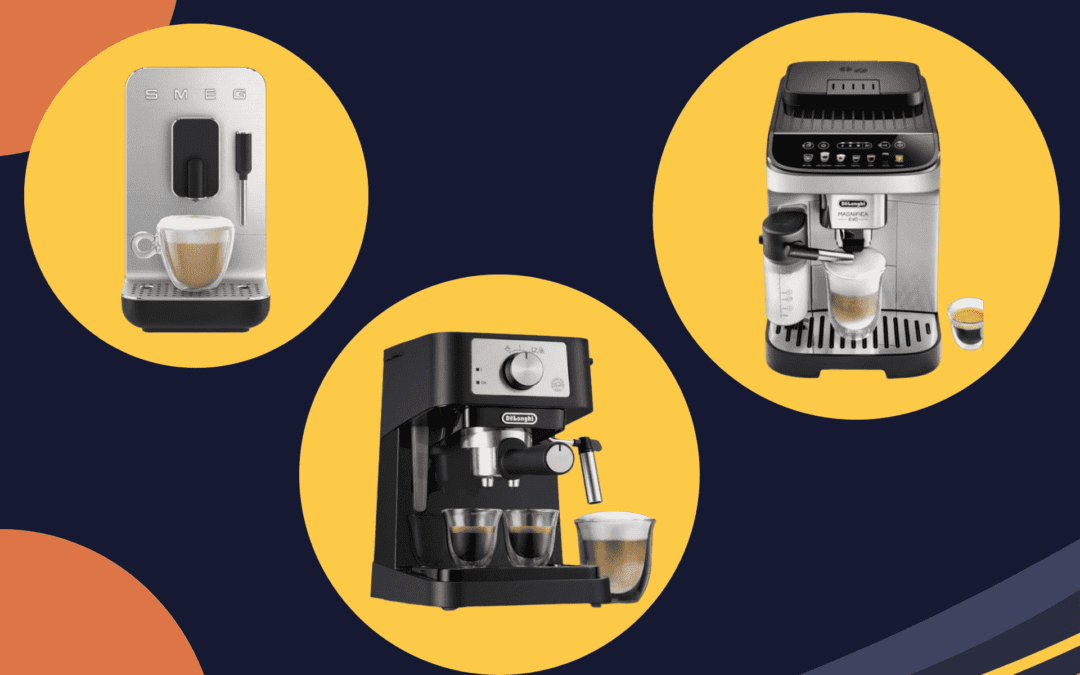



0 Comments